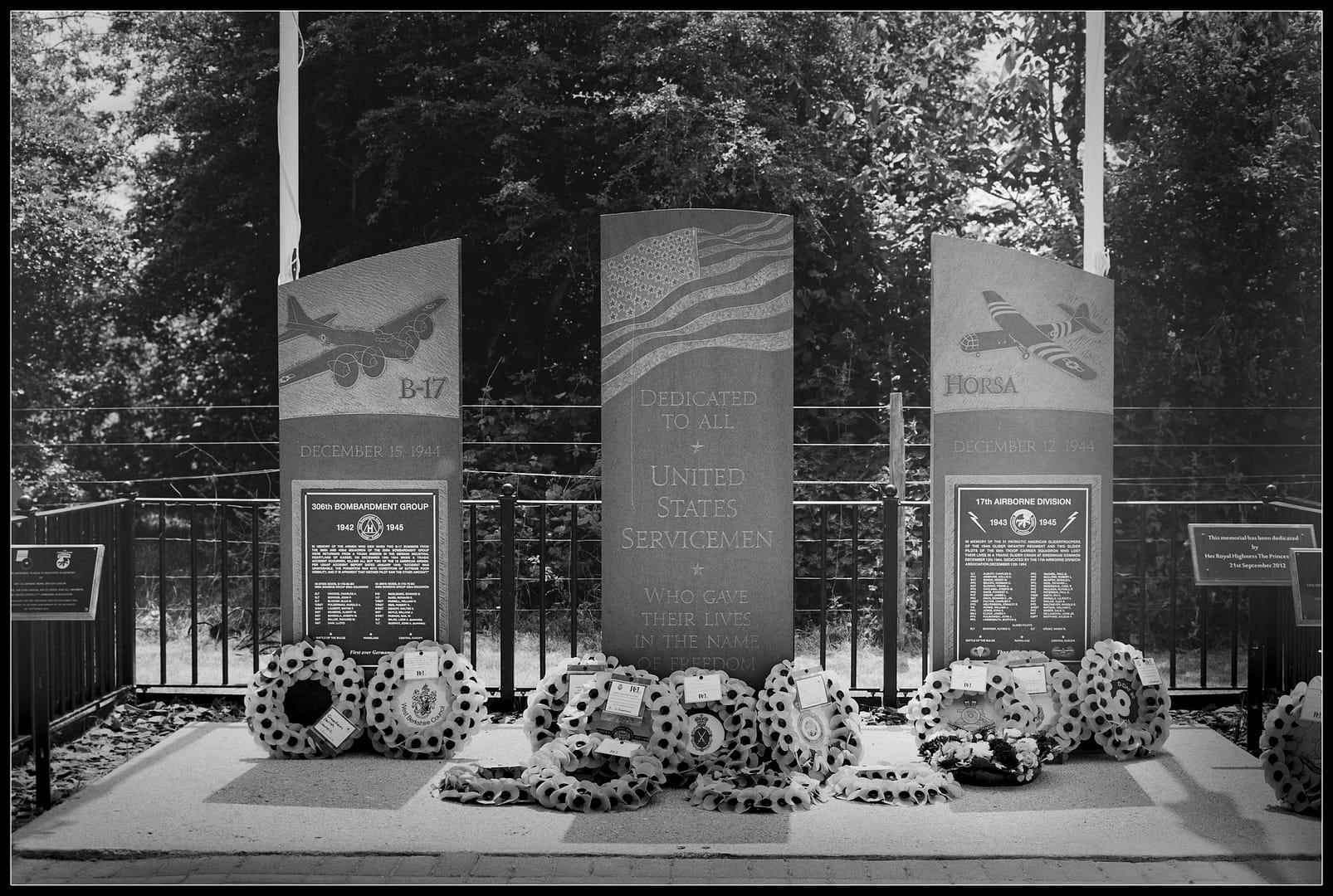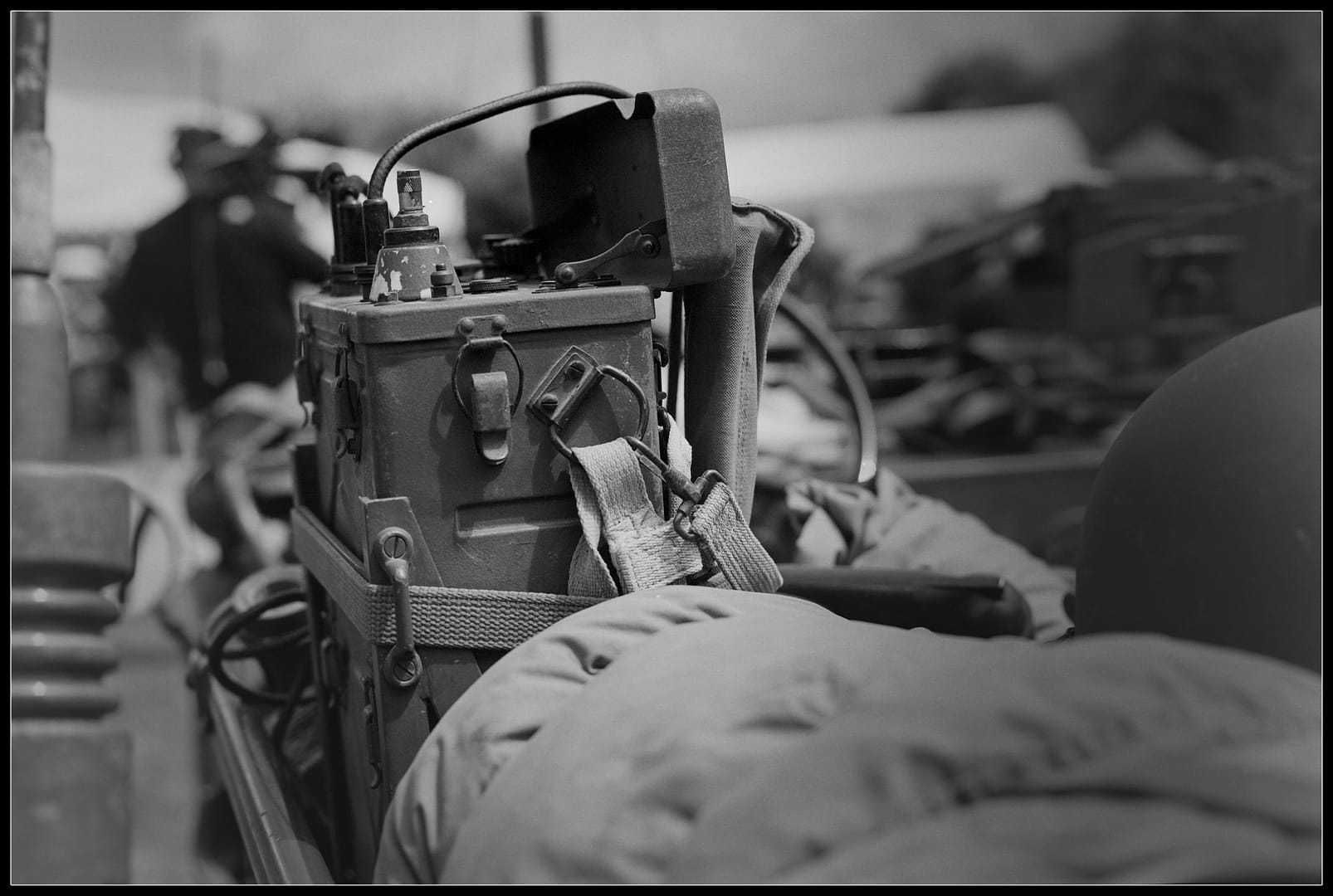Black and white photography has a unique allure that transcends time, stripping away the distractions of colour to reveal the essence of the subject.
Attending the commemorative event at the Control Tower at the former RAF base at Greenham Common presented me with a perfect opportunity to harness the power of black and white photography. This site, rich with historical significance, was once at the heart of pivotal moments during the Cold War. The Control Tower, now a symbol of reflection and remembrance, stands as a testament to the past.
Photographing this event in black and white photos not only highlighted the details of the Control Tower but also captured the vintage collections which included some old vehicles from the WW2 era. Each photograph tells a story of reverence and remembrance, providing a timeless record of a day dedicated to honouring history.
Full Gallery of photos and a short movie clip of the photos can be found at base of this post.
Table of Contents
Tools of the Trade
For this commemorative event at Greenham Common, I brought along two trusted companions: the Bronica ETRSi and the Canon AE-1 Program. Each camera offered its own unique strengths, allowing me to capture a diverse range of images.
The Bronica ETRSi, a medium format camera renowned for its exceptional image quality and detail, was loaded with Ilford FP4+ film. Although FP4+ is typically rated at ISO 125, I pushed it to ISO 400 for this shoot. Pushing the film enhanced its versatility in varying light conditions and added a pleasing grain to the images, further emphasising the historic atmosphere of the event. The film was developed in Ilford Ilfosol 3, a developer known for its fine grain and sharpness, which complemented the medium format negatives beautifully.
On the other hand, the Canon AE-1 Program, a 35mm SLR celebrated for its reliability and ease of use, was loaded with Kodak TriX 400 ISO film. This was my first experience with Kodak TriX 400, and I was eager to see how it would perform. The higher ISO rating allowed for greater flexibility in capturing spontaneous moments, especially in the varying light of the Control Tower’s interior.
Together, these cameras and films provided a rich tapestry of tones and textures, perfectly suited to document the event’s significance in timeless black and white.
Arrival at Greenham Common – D-Day 80
Arriving at the former RAF base at Greenham Common was a journey through time. As I approached the site, the expansive landscape and the lingering aura of its storied past became immediately palpable. The base, now quiet and still, once buzzed with the activity of a pivotal Cold War hub.

My initial steps were met with a mix of emotions. The open spaces, now overtaken by nature, whispered tales of a bygone era. The remnants of runways stretched out, now cracked and weathered, serving as silent reminders of the jets that once roared across them. In the distance, the Control Tower stood as a sentinel of history, its presence commanding attention and respect.
The ambiance was one of solemn reverence. The sky, overcast and grey, seemed to mirror the subdued mood of the location. It was as if the very air carried the weight of memories, of missions launched and lives changed. The medium format camera, with its ability to capture fine detail and texture, was perfect for these introductory shots.
Moving closer to the heart of the base, the historical significance of Greenham Common became even more apparent. Informational plaques dotted the landscape, offering glimpses into the base’s past. They spoke of its role during the Cold War, the anti-nuclear protests that took place here, and the strategic importance of its location. These narratives, combined with the visual cues of the base’s architecture, painted a vivid picture of its legacy.
The Control Tower: A Journey Back in Time
Entering the Control Tower was like stepping into a time capsule. The building, though weathered, retained much of its original structure and charm. The exterior, with its stark lines and utilitarian design, spoke of an era where function trumped form. Inside, the air was thick with the echoes of history.
The first floor, now repurposed as a small museum, provided an intimate look at the base’s past. Photographs, documents, and artifacts were meticulously displayed, each telling a piece of Greenham Common’s story. One exhibit featured black and white photographs from the height of the Cold War, mirroring the style of photography I was there to practice. These historical images, filled with soldiers, aircraft, and moments of everyday life, offered a profound connection to the past.

Climbing the narrow stairs to the control room was a highlight of the visit. The steps, worn from decades of use, adding to the sense of authenticity. The control room itself was a fascinating space. Large windows provided a panoramic view of the base, allowing me to imagine the bustling activity that once filled the air. The room was sparse, yet every item had a purpose: old radios, a rusted intercom system, and faded charts pinned to the walls. These relics, though no longer in use, were rich with stories.
As I descended the stairs and exited the tower, I felt a profound sense of connection to the past. The Control Tower at Greenham Common, with its unique architectural features and historical artifacts, had provided a powerful journey back in time. Each photograph taken was not just an image, but a story captured in monochrome, preserving the legacy of a place that once stood at the crossroads of history.
Moments of Reflection: Capturing Emotions
The commemorative event at Greenham Common was a heartfelt gathering, honouring the legacy and historical significance of the former RAF base. Attendees included veterans, historians, local residents, and relatives of those who served. Each person brought with them a personal connection to the site, making the event deeply poignant. The gathering commemorated the base’s role during the Cold War, as well as the powerful anti-nuclear protests that took place there, highlighting its complex and multifaceted history.
The Bronica ETRSi Experience: Ilford FP4+ at ISO 400

Using the Bronica ETRSi at Greenham Common was an enriching experience, offering a perfect blend of technical excellence and artistic expression. The choice of Ilford FP4+ film, typically rated at ISO 125 but pushed to ISO 400 for this shoot, was strategic. Pushing the film increased its sensitivity, allowing for better performance in the variable lighting conditions of the day.
The Bronica, with its medium format, provided stunning detail and a richness that 35mm cameras often struggle to match. The format encouraged a different approach to composition, making me more mindful of every element within the frame. The Ilford FP4+, renowned for its fine grain and wide dynamic range, handled the push to ISO 400 remarkably well, adding a subtle grain that enhanced the historical atmosphere of the images without compromising on detail.
Developing the film in Ilford Ilfosol 3 was a deliberate choice, aimed at maximising the sharpness and tonal range. Ilfosol 3 is known for producing fine-grain negatives with excellent definition, and it lived up to its reputation. The development process was straightforward, and the negatives emerged crisp and rich in contrast.
The pushed film added a dramatic grain, which, combined with the high contrast, created images that felt both timeless and immediate.
In conclusion, the Bronica ETRSi paired with Ilford FP4+ at ISO 400 proved to be an ideal setup for documenting the commemorative event at Greenham Common. The combination of technical excellence and artistic nuance resulted in photographs that not only captured the physical reality of the day but also the emotional and historical weight of the occasion.
The Canon AE-1 Program Experience: First Time with Kodak TriX 400ISO

Using the Canon AE-1 Program at the Greenham Common event was a gratifying experience. This classic 35mm SLR is renowned for its reliability and ease of use, making it an excellent choice for capturing spontaneous moments. The camera’s solid build and intuitive controls allowed me to focus on composition and timing without worrying about technical mishaps.
This was my first time using Kodak TriX 400ISO film, and I was eager to see how it would perform. Kodak TriX 400ISO is designed for versatility, handling a range of lighting conditions with ease. The higher ISO rating was particularly useful in the mixed lighting environments of the Control Tower and the outdoor areas, providing flexibility without requiring frequent adjustments.
One of the most notable outcomes was the film’s ability to render fine details while maintaining a pleasant grain structure. The grain added a layer of texture that complemented the historical context of the event.
Comparing Kodak TriX 400ISO to other films I’ve used, such as Ilford HP5+ and Fujifilm Neopan, I found that Kodak TriX offers a balanced mix of fine grain and high contrast. While Ilford HP5+ tends to be more contrast-heavy, Kodak TriX provides a softer gradation of tones, making it well-suited for capturing the subtle nuances of expression and texture. Overall, I was impressed by its performance and versatility, making it a worthy addition to my film repertoire.
The Power of Black and White Photos in Commemorative Photography
Attending and photographing the commemorative event at Greenham Common was a deeply enriching experience. The combination of historical significance, emotional depth, and the unique setting provided a wealth of photographic opportunities. Black and white photography, with its ability to focus on light, shadow, and texture, proved to be the perfect medium for capturing the essence of the day.
The photographs taken not only documented the event but also conveyed the emotional and historical weight carried by the attendees and the location itself. These moments, captured in monochrome, gain a timeless quality that resonates beyond the frame.
Reflecting on the experience, I am reminded of the power of black and white photography to distill complex scenes into their most impactful elements. The absence of colour directs the viewer’s attention to the core of the image—the expressions, the light, the composition—creating a more profound connection with the subject.
I encourage readers to explore black and white photography, especially for commemorative events or moments of personal significance. The timeless nature of black and white images can transform fleeting moments into enduring memories, capturing the true essence of the occasion in a way that colour photography often cannot. Through this medium, we can honour the past, celebrate the present, and create a visual legacy for the future.
Photo Gallery: A Collection of Moments
Here’s a curated selection of the best photos from the commemorative event, capturing the essence of the day from arrival to departure.
Conclusion: Looking Back, Moving Forward
Attending and photographing the commemorative event at Greenham Common was a powerful and reflective experience. The photographs taken not only document the day but also capture the deep emotional resonance of the site and its history. Black and white photography, with its timeless quality, proved to be the perfect medium to convey the weight and significance of the occasion.
I invite readers to share their thoughts or their own experiences with black and white photography. Whether you’re capturing moments of personal significance or documenting events of historical importance, the timeless nature of black and white images can transform fleeting moments into lasting memories. Through this medium, we can continue to honour the past, celebrate the present, and create a visual legacy for the future.
































